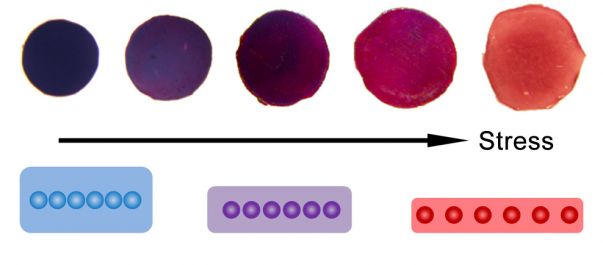University of California researchers have come with a novel high-resolution pressure sensor that displays via several colors the amount of pressure applied on any surface, thus making the sensor visible to the naked eye. This opens several interesting avenues where we may apply the sensor on our everyday products – for example, automobile manufacturers may paint their crash-testing dummy cars with a coating that changes colors according to varying amounts of stress. Once the crash test can performed, these color codes/color map can detail them with important information about stress endurance on various parts of the vehicle. This information can then be later applied to design safer cars in the future. In another application, this tech could be used in the gloves worn by different sportsmen. By studying the colors depicted on the pressure sensor, they can understand the appropriate amount of pressure that they should be applying to grip their racquets/bats.

Yadong Yin, Associate Professor of Chemistry at UC, Riverside, led the team which conducted this research called “colorimetric stress memory sensor”. By employing a self-assembly, gold nanoparticles were strung together and later embedded into a polymer film. Since this film deformed when pressure was applied to it, the gold nanoparticles stretched by the increase in distance between adjacent gold nanoparticles, and hence their interaction with light varied. When initially linked, the old nanoparticles appear blue, but with increasing pressure and the disassembling of nanoparticles, they gradually change their color to red. The image below shows different colors with varying pressure.
The gold nanoparticle-based high-resolution sensor is different from the pressure sensor films in use today. The latter offer low resolution and low contrast, and display pressure change by varying intensity of just one color (light red becomes dark red). The new sensor created by Yin’s team produces a template of easily separable colors that feature both higher resolution and higher contrast. A bonus is that these sensors work on complex uneven surfaces too. Yin adds that instead of the expensive gold, cheaper options like copper or silver could be used too.
The researchers add that by reversing the process of disassembly, the sensors undergo reverse color change, i.e., from blue to red. And this disassembly could be achieved by applying simple mechanical force. You may go through their study results published in Nano Letters to know more about the work they did.
Source: University Of California
University of California researchers have come with a novel high-resolution pressure sensor that displays via several colors the amount of pressure applied on any surface, thus making the sensor visible to the naked eye. This opens several interesting avenues where we may apply the sensor on our everyday products – for example, automobile manufacturers may paint their crash-testing dummy cars with a coating that changes colors according to varying amounts of stress. Once the crash test can performed, these color codes/color map can detail them with important information about stress endurance on various parts of the vehicle. This information can then be later applied to design safer cars in the future. In another application, this tech could be used in the gloves worn by different sportsmen. By studying the colors depicted on the pressure sensor, they can understand the appropriate amount of pressure that they should be applying to grip their racquets/bats.
Yadong Yin, Associate Professor of Chemistry at UC, Riverside, led the team which conducted this research called “colorimetric stress memory sensor”. By employing a self-assembly, gold nanoparticles were strung together and later embedded into a polymer film. Since this film deformed when pressure was applied to it, the gold nanoparticles stretched by the increase in distance between adjacent gold nanoparticles, and hence their interaction with light varied. When initially linked, the old nanoparticles appear blue, but with increasing pressure and the disassembling of nanoparticles, they gradually change their color to red. The image below shows different colors with varying pressure.
The gold nanoparticle-based high-resolution sensor is different from the pressure sensor films in use today. The latter offer low resolution and low contrast, and display pressure change by varying intensity of just one color (light red becomes dark red). The new sensor created by Yin’s team produces a template of easily separable colors that feature both higher resolution and higher contrast. A bonus is that these sensors work on complex uneven surfaces too. Yin adds that instead of the expensive gold, cheaper options like copper or silver could be used too.
The researchers add that by reversing the process of disassembly, the sensors undergo reverse color change, i.e., from blue to red. And this disassembly could be achieved by applying simple mechanical force. You may go through their study results published in Nano Letters to know more about the work they did.
Source: University Of California